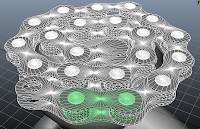Emily Rodgers –In
search of
In Emily
Rodgers' mfa thesis exhibit She focuses on houses and their intiors ,
particularly in the Reno area west of wells.
All of her pictures in this exhibit do not contain any people, forcing
the viewer to focus on the space, forms, and lines that the buildings
create. In her thesis presentation she
explained how she likes to show hints that people have lived in these houses
without actually showing the people. She
accomplishes this by including details such a dent in the wall, wear patterns
in a carpet, and tire tracks in the snow in her photographs. She is interested in finding a story but
leaving some parts of it unanswered.
In here
thesis presentation she talked about her method of finding homes to
photograph. She would look through old
newspapers and look for events that happened in the particular neighborhood she
was interested in. She would take
advantage of the fact that old newspapers used to print the addresses where
things happened and she would revisit the houses. She would explain to the owner what had
happened there and often the owners of the houses would be intrigued and let
her take pictures of their home.
My favorite
work in this exhibit (Unknown name) is of a window sill that is painted white
and the paint on the top has been worn away to expose the green and brown
layers under the white. There is a light
ray and shadow being cast by an unknown source
that creates vertical lines in the scene and some interesting tonal gradients. The only lines in this piece are horizontal
and vertical lines giving the piece a Piet Mondriaan feel.
Another
piece in this exhibit I found interesting is of a door with light shining
through the edges. This piece has many
subtle details that suggest a story, yet like Rodgers wanted, the full story is
left untold leaving the viewer searching through the photo for more. There is a wearing in the carpet that
suggests that this scene has been through a lot of repetitive foot traffic
throughout the years. The blinds in the
window hang down crooked showing their age.
The dirt on the door hints that little kids live (or lived) in the
house. And the light creeping around the
edges of the door suggest that outside of this old musty house it is a nice and
sunny day. These details definitely tell
a story, although it may not be entirely clear, which serves to peak interest
in the viewer.
Emily
Rodgers exhibit “In search of” is an interesting and well-put together body of
work. All the images in this gallery fit
together and compliment each other nicely.
Rodgers was very successful in accomplishing what she set out to do: to
tell parts of a story, while leaving just enough out to make the viewer
interested.
























